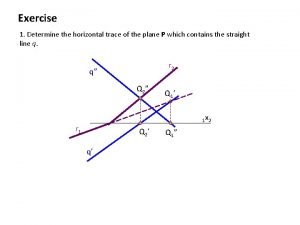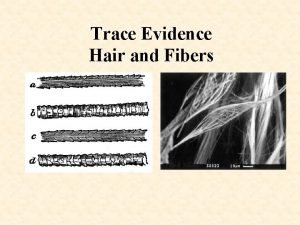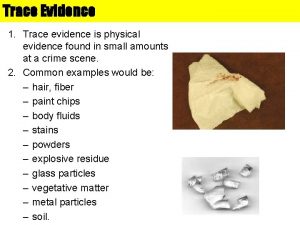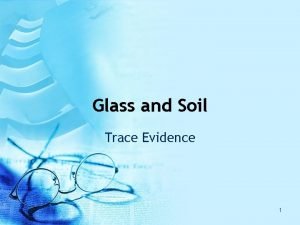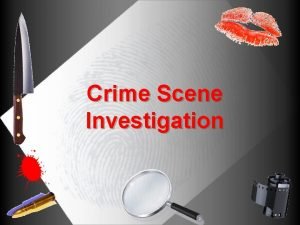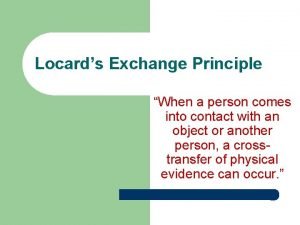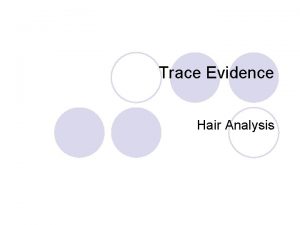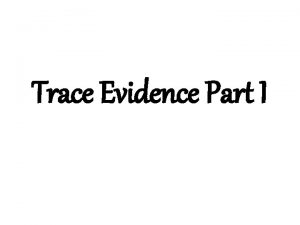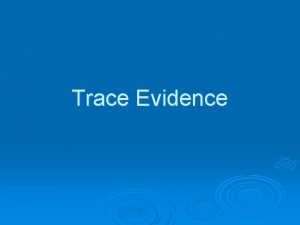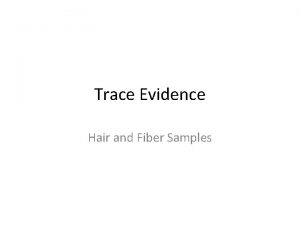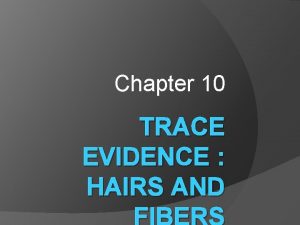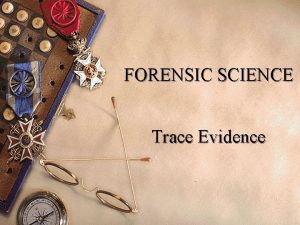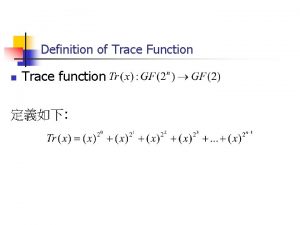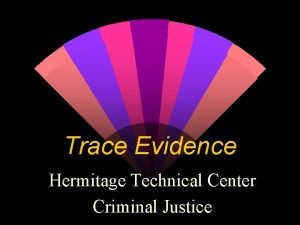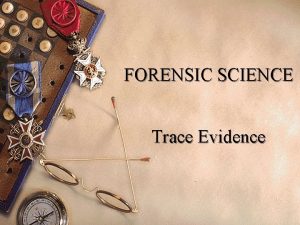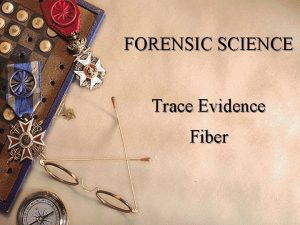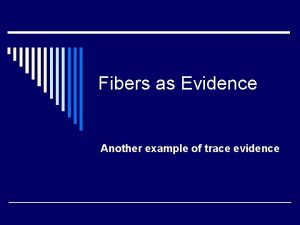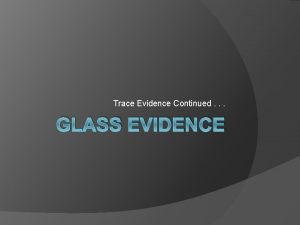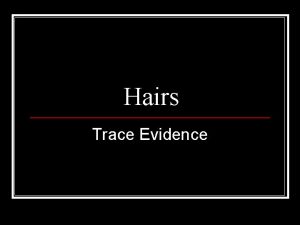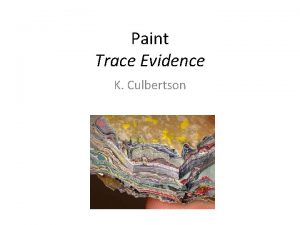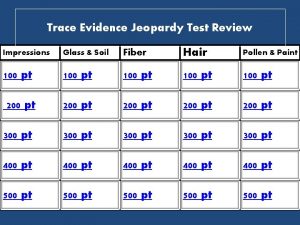TRACE EVIDENCE 1 2 Test Questions for Trace















































- Slides: 47

TRACE EVIDENCE 1

2

Test Questions for Trace Evidence u What is it? u Is it man-made or natural? u What is its source? u How common is it? u Can it be identified to a single source? 3

Introduction Trace Any material which, when left behind at scene or, on the body of victim or assailant or, any other thing that acts as clue and can be presented in the court as an evidence. This is important as it can definitively link an individual or object to the scene. 4

u It helps in the recognition of the evidence and its association with a particular: u Person u Thing u Place u and acts as a clue for the identity of that source 5

The procedures involved in Medico-Legal cases are different from those involved in the clinical labs and requires special knowledge u HOW ? u 1. The place of collection / sampling u 2. Interest of parties involved u 3. Safety against tampering u 4. Chain of custody 6

Trace Evidence Analysis u Because trace evidence can be any number of things, from a fingerprint to DNA to plant debris, there are numerous different methods used for analysis. u For some objects, there is a large database available for comparisons (fingerprints, DNA), while the science of others has not advanced that far. 7

Locard’s Principle u Every person who is physically involved in a crime leaves some minute trace of his or her presence, and often takes something away. u This is Dr. Edmond Locard's principle of contact, proposed when he began his forensic laboratory in 1910. 8

9

Objectives of Study 1 - Identification of unknown u 2 - Confirmation of a previously known identity u An attempt is made to establish similarity or dis-similarity between two or more objects one of which has come from a known source. u Comparing this trace with a control taken from the source from where it is suspected to have come, will confirm the character of a trace and its association is established u 10

u The scientific study of the specimens pre- requires: 1. Collection of Material from source 2. Its Preservation 3. Despatch to the laboratory 11

u The specimen may be present in three forms, - Dry Form - Wet Form - Mixed with other Paticles 12

Collection Dry Form – Scrap the specimen and place in a funnel of glazed paper, or – Soak the cotton swab in normal saline and apply it over the dry stain, then dry this swab in air and use this swab as specimen. Wet Form -Dry the specimen and then scrap it or wipe it with wet cotton swab. Mixed Form -Cut that portion and separate it 13

Packing and Preservation 14

u Enclose small items (e. g. hairs, fibers, paint scrapings or glass fragments) in properly labeled and sealed paper pharmaceutical folds. u Enclose the paper fold in a sealed outer container such as an envelope or plastic bag. u Do not put clothing, damp items or items bearing biological evidence in plastic bags. u Each piece of evidence must be packaged separately. 15

Labelling All items must be clearly labeled with: u a description of the contents, u location where collected, u date and time of collection, u Preservative used, u Investigator’s name and agency, u case number, u and exhibit number 16

Sealing of Specimens u All the specimens should be sealed with Sealing wax to avoid tempering and to maintain secret chain of custody u All the containers or jars should be packed in one box, and the box should be labelled indicating: -Address to be sent - Arrow showing Upside -Box should be sealed -Box should accompany a forwarding letter 17

Despatch of The Specimens u Specimens should be collected, preserved, and despatched immediately after autopsy. u The only condition in which the specimens are allowed to be kept is that when the autopsy is conducted at odd hours, when the lab is closed. 18

Safe Storage u The specimens should be kept in lock and key in the freezers. u The specimen should be registered u The seal should be intact 19

Transportation The specimens should be transported, 1. Through Police 2. Through Railway Parcel 3. Through Postal Parcel 4. Through Special Messenger by hand 20

Classification on the basis of the source Trace evidence may be grouped into: 1. Biological Evidence 2. Non-Biological Evidence 21

Classification On the basis of the analysis u Microscopic Trace Evidence u Impression Trace Evidence 22

Impression Trace Evidence Shoeprints & Tire Tracks u • Impression evidence can be photographed, lifted with tape, or cast with plaster to compare to a suspect’s shoes or tires. u • Investigators will examine the evidence to identify the brand of shoe or tire based on its tread pattern and other physical features to provide leads in the case. u • Shoes and tires will also show wear patterns after being used for a period of time as well as other features (scratches, nicks, and cuts) that can be used to match evidence to specific items. For example, shoeprints can be matched to a suspect based on how the treads on the shoes that are worn down due to that person’s walking style. 23

Bite Marks • Each of the 32 teeth in humans is unique due to age and wear. • Impressions and photographs of bite marks left on a victim, assailant, or other object at a crime scene can often be matched to dental records. 24

Tool Marks • Tiny nicks and chips form on the edges of a tool as it is used, which can be used to identify matches between evidence and suspects. • Tools may also pick up traces of blood or other substances that can be tested or have fingerprints that can be lifted. 25

Biological Evidence These originates from human, animal or plant source and include mainly : 1. Body Fluids 2. Body Tissues 3. Botanical Remains 26

Non-Biological Evidence These comprise of 1. Items of Personal Use 2. Other Materials found in the Environment (Foreign Bodies) 27

u These Personal Items are Clothes, Spectacles, Purse, Wristwatches, or other things in use. u The Environmental Materials are fibres from carpet, vegetation in the garden, grit particles from the road. u Other Non-Biological materials consists of bottles, tablets, bullets or pellets, weapons of offence or any other thing used in the crime. 28

Some usual non-biological evidences u Glass u Fibers u Gunshot Residues u Paints and coatings u Plastics and polymers 29

Fractured Materials (Physical Matches) u It is possible to examine any broken, torn or separated items to determine whether or not they were at one time a single, intact item. u This type of examination can determine if evidence did originate from one particular source. 30

u This becomes a truly three-dimensional comparison, focusing not only on the surface characteristics but also on the crosssectional topology of the fractures u Examples of materials an analyst can examine are plastic, glass, metal, tape, wood, paper, and fabric 31

Glass u Inorganic product of fusion u By heating a mix of sand (silicon dioxide, Si. O 2), limestone (calcium carbonate), and soda (sodium carbonate), along with various impurities u Window glass: Soda-lime glass (not very strong) u Tempered glass: vehicle windows (much stronger) 32

Glass Analysis u A glass analyst can determine whether samples of glass could have originated from the same source by observing a variety of physical, optical and elemental properties of the glass. u The physical and optical characteristics would be noted using ultra-violet light, stereomicroscopy, and brightfield/polarized light microscopy 33

Glass Analysis u GRIM (Glass Refractive Index Measurement) - changes when glass is heated u Density of the glasses u Compositional analysis-to determine and compare the chemical elements u The direction of force used to break a piece of glass 34

Important Things u u u Projectile hits-the glass bends slightly before breaking A fast-moving projectile, such as a bullet, will leave a crater-shaped hole in the pane of glass A slow-moving projectile will usually shatter the entire pane Tiny shards of glass-found on the clothes of anyone standing in the vicinity These fragments will cling to clothing and footwear even after washing However about 90% of glass fragments are shed from clothing within 24 hours of deposition. 35

The pattern of cracks in a windshield fracture can reveal information about speed, occupant position, and angle of impact. 36

What a glass analysis can reveal? u Whether questioned fragments could (or could not) have originated from a particular source u From which side of the glass a force was applied to break it (direction of force) u Whether broken fragments were at one time a single piece (fracture match) 37

Paint A manufactured liquid u Constituents: carriers, pigments, modifiers, extenders and binders u Carrier: solidifies on evaporation of the solvent, an organic liquid u Pigment: gives the paint its color Blue and green pigments: organic compounds Red, yellow and white colors: inorganic u Modifiers: flexibility, gloss, and chip resistance u Extenders: adds volume u Binders: synthetic resins which stabilise and 38 enhance the paint u

Paint Analysis u Mechanical: Attempt to make matches between flakes of paint-jigsaw puzzle u Physical: color, texture, thickness, appearance, and the pattern of occurrenceusing microscopy u Chemical: exact composition of a sample using various chromatography techniques 39

Paint Transfer on a Car u Automobile’s paints in accidents (hit and run) are very important evidences 40

Physical Match of Paint Chip Edges 41

Plastics are used in a wide variety of modern products: u Vehicle parts, u Decorative trim tapes u Decals u Adhesive tapes (duct, electrical, masking, etc. ) u or Rubber may be broken or transferred from one source to another 42

Plastics Analysis u Techniques similar to paint analysis u The analyst must have a good understanding of the materials 43

Gunshot Residue/ Explosives u u During the discharge of a firearm, escaping gases from the weapon deposit gunshot residue (GSR) on the skin of the shooter’s hands, on the clothing of the shooter, and on other objects located in close proximity Explosive substances can be examined to determine its chemical composition to identify the type of explosive used and its origin. Traces of explosives found on a suspect’s clothing, skin, hair, or other objects may be matched to explosives from the crime scene. Materials used to make an explosive device will be compared to evidence found in the suspect’s 44 possession to confirm a match.

Most common constituents u Lead styphnate u Barium nitrate, u Antimony sulfide 45

Gunshot Analysis u Analysis and characterization of the residue for the trace elements (lead, barium, and antimony) are used to indicate if a suspect has fired, handled, or been in close proximity to a weapon when it was fired u Gunshot residue kits should be processed as instructed in the kit and sealed with tape 46

Thermal Desorption Scientists use thermal desorption to transfer explosives residue from a Teflon® wipe into a special type of tubing called a gas chromatography column. The wipe is heated to well above room temperature. At the higher temperature, the organic explosives become a gas and are gently swept onto the gas chromatography column. The gas chromatography column is at room temperature, so the explosives’ vapours condense onto the walls at the entrance to the column for later separation and analysis. 47
 Trace of a plane
Trace of a plane Hair and fiber evidence
Hair and fiber evidence What is trace evidence examples
What is trace evidence examples Trace evidence examples
Trace evidence examples Soil trace evidence
Soil trace evidence Line/strip search pattern
Line/strip search pattern Locards exchange principle
Locards exchange principle Primary evidence vs secondary evidence
Primary evidence vs secondary evidence Primary evidence vs secondary evidence
Primary evidence vs secondary evidence Primary evidence vs secondary evidence
Primary evidence vs secondary evidence Primary evidence vs secondary evidence
Primary evidence vs secondary evidence Primary evidence vs secondary evidence
Primary evidence vs secondary evidence How can class evidence have probative value
How can class evidence have probative value Class vs individual evidence
Class vs individual evidence Difference between testimonial and physical evidence
Difference between testimonial and physical evidence A pair of latex gloves was found at a crime scene
A pair of latex gloves was found at a crime scene The ecological fallacy
The ecological fallacy Iso 22301 utbildning
Iso 22301 utbildning Novell typiska drag
Novell typiska drag Nationell inriktning för artificiell intelligens
Nationell inriktning för artificiell intelligens Vad står k.r.å.k.a.n för
Vad står k.r.å.k.a.n för Varför kallas perioden 1918-1939 för mellankrigstiden?
Varför kallas perioden 1918-1939 för mellankrigstiden? En lathund för arbete med kontinuitetshantering
En lathund för arbete med kontinuitetshantering Kassaregister ideell förening
Kassaregister ideell förening Tidbok för yrkesförare
Tidbok för yrkesförare A gastrica
A gastrica Densitet vatten
Densitet vatten Datorkunskap för nybörjare
Datorkunskap för nybörjare Stig kerman
Stig kerman Hur skriver man en tes
Hur skriver man en tes Magnetsjukhus
Magnetsjukhus Nyckelkompetenser för livslångt lärande
Nyckelkompetenser för livslångt lärande Påbyggnader för flakfordon
Påbyggnader för flakfordon Kraft per area
Kraft per area Svenskt ramverk för digital samverkan
Svenskt ramverk för digital samverkan Lyckans minut erik lindorm analys
Lyckans minut erik lindorm analys Presentera för publik crossboss
Presentera för publik crossboss Argument för teckenspråk som minoritetsspråk
Argument för teckenspråk som minoritetsspråk Bat mitza
Bat mitza Klassificeringsstruktur för kommunala verksamheter
Klassificeringsstruktur för kommunala verksamheter Epiteltyper
Epiteltyper Claes martinsson
Claes martinsson Cks
Cks Lågenergihus nyproduktion
Lågenergihus nyproduktion Mat för idrottare
Mat för idrottare Verktyg för automatisering av utbetalningar
Verktyg för automatisering av utbetalningar Rutin för avvikelsehantering
Rutin för avvikelsehantering Smärtskolan kunskap för livet
Smärtskolan kunskap för livet
